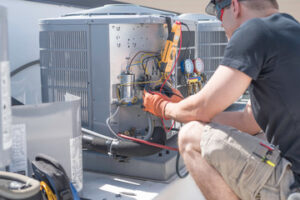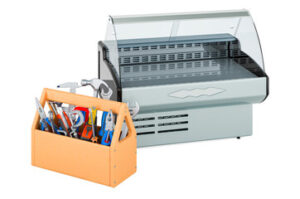Heating repair is an essential part of keeping your home comfortable. It also helps protect you from the life-threatening dangers of hypothermia.
Uneven heating is a sign that there’s a problem with your furnace. It could be something as simple as a dirty air filter or it might be a more serious issue like a crack in your heat exchanger. If you are unsure, schedule an appointment by clicking https://comfortprosheatandair.com/ today! Our heating repair experts are ready to help you. We’ll have you warm in no time! You can also do the following:

Check the Thermostat
The thermostat sends a signal to your furnace or air conditioning system to turn on when the temperature gets too low or too high. So, if your system isn’t turning on, it could be because the thermostat is broken. The good news is that you can test the thermostat’s functionality with a few simple steps.
First, remove the cover from the thermostat. Then, use a flathead screwdriver to open the main plate and get access to the wires inside. The wires should be screwed to terminals labeled R (red), W (white), G (green), Y (yellow) and C (common). Make sure to take a picture with your phone of the wiring connections so that you can reference them later.
Once you’ve removed the plate, check the wires to see if they’re disconnected or corroded. If you find any, reattach them using needlenose pliers and twist them tightly. You can also re-tighten the screws to ensure that they’re securely in place.
Next, tape a household thermometer to the wall next to your thermostat. Make sure that the thermometer is properly calibrated and that it’s reading the same temperature as the thermostat. If the two temperatures are the same, then your thermostat is working correctly.
If the thermostat is not reading correctly, or if it’s making strange noises or smelling like burning dust, it might be time to call a heating repair professional for a full inspection. Regularly performing routine HVAC maintenance can help extend the life of your equipment and ensure that it’s running at its peak efficiency.
Check the Furnace
When the air turns chilly, you need to have your furnace ready to keep your home comfortable. A heating system that is not functioning properly can create a lot of stress and discomfort.
One of the most common problems that prevents a furnace from turning on is a clogged air filter. A dirty filter restricts airflow, which is why you should change it at least once a month. In addition, you should clean the area around your furnace and make sure that it is free of flammable materials.
Another problem that may cause your heater to not turn on is a dirty ignitor or ignition sensor. This is a simple fix that you can do yourself, but it is important to turn off the power and gas before you begin. You will also want to remove the front cover of the furnace and inspect the sensor or ignitor for dirt. You can use a screwdriver to remove the ignitor and sensor and clean them carefully. Be sure to follow the manufacturer’s instructions for doing this.
If you have checked the thermostat and the air filter and still have a problem with your furnace, it could be a problem with the heat exchanger. This is a tube-shaped metal structure inside your furnace that is used to heat the air and distribute it throughout your home. It can become rusty and warped over time, which leads to decreased heating efficiency and carbon monoxide leaks.
If your heat exchanger is rusty or warped, you will need to have it replaced by a professional. Another possibility is that the fan limit control switch is faulty. This is a safety device that monitors the temperature inside your furnace and shuts off the components when it reaches a certain set temperature. It is possible that this can reset itself over time, so it is important to have a professional check it regularly.
Check the Drain Lines
While some heating maintenance tasks require a professional, you should be able to perform most of the basic routines yourself. This includes ensuring the drain lines are clear of clogs. This will prevent water damage to your ceiling. Clogged drain lines are not only costly to repair, but they can also lead to mold and other health issues.
To check the drain line, first make sure your air conditioner is completely turned off. This includes switching the thermostat to “off” and turning off the circuit breaker. Locate the narrow PVC pipe that runs out from the furnace and leads to the drainage pan. This will usually be located outside, where the condenser unit sits. It’s typically capped off with a plastic cap, which you can easily remove with your hands.
Once the cap is removed, you can visually inspect the drain line to see if there are any clogs present. You should be able to easily spot any debris in the area by shining a flashlight on the area.
If you do spot any clogs, they can usually be cleared with a wet/dry vacuum. Just make sure to use a vacuum with a strong suction capacity, which will be necessary to clear any stubborn debris. Alternatively, you can also try flushing the drain line with vinegar. This is a simple and inexpensive DIY method to clear most clogs.
Another easy way to protect your drain lines is by insulating them. You can purchase insulation tubes called rebates that are specifically designed for piping, and simply slip them onto the end of your drain lines. This will keep the cold PVC pipes from “sweating” and causing a clog. This is a quick and inexpensive DIY solution that will help you protect your investment and prevent expensive repairs.
Check the Electrical Connections
A common electrical problem that can cause your heater to stop working is a bad wiring connection. This is usually a sign that there is a more serious problem with the wiring in your home, such as a blown fuse, or it could even be a power outage, which would require a professional technician to troubleshoot and fix.
Usually, your wall-mounted electric heater is hard-wired into household electrical circuits through a set of wire leads that are soldered to the unit’s metal housing. When the outer insulation of these wires is damaged by rodents or by age, it can break down and expose the inner copper core to damage from water, heat, and other sources. These exposed wires are susceptible to short-circuiting, which can be dangerous if you don’t have the proper tools and knowledge to handle the job.
Start by checking that the circuit breaker and high-temperature cutoff switch are both on and not tripped. If they are, reset them to the on position. If the breaker trips again and again, there is likely too much electrical demand on that circuit, which may be caused by equipment like your HVAC system or a washer/dryer that needs special circuits to accommodate their high amperage requirements.
You can check the electrical wiring by visual inspection and with a volt ohmmeter. The latter has two probes with different scales that measure resistance, which can help you determine whether there is a bad connection or an internal wiring issue. Before you start testing, be sure that your multimeter can read resistance, and have the necessary tools such as insulated pliers, screwdrivers, and a wire stripper.
Check the Thermostat Settings
It can be frustrating when your thermostat just won’t do what you want it to. But if you’re not sure where to start, try a couple of easy fixes before calling for help.
Check the Screen
The first thing to do is see if your thermostat’s screen is still lit up. If not, this could mean that it has lost power completely and needs to be reset. This can be done by flipping the switch on your circuit breaker. If the screen still doesn’t come on, you may need new batteries or the breaker may have been tripped by another electrical issue.
Make Sure It’s Working
You can test your thermostat by manually adjusting it to a different temperature. This is typically the easiest way to tell if the problem lies with your thermostat or with your HVAC system. Usually, you’ll hear a small click when you turn the dial. This is the signal being sent to your HVAC system, and in a few minutes, you should feel warm or cool air flowing out of your vents or your return vents sucking in fresh air.
If this doesn’t work, it might be a wiring or circuit board problem with your thermostat that’s keeping it from relaying temperature change signals to the HVAC system. A professional will be able to figure out the problem and determine the best solution.
As the cold weather sets in, you’ll want your family to be comfortable and cozy inside. However, it’s important to balance that with the desire to reduce your energy costs. Using the proper thermostat temperature settings can keep your home warm and safe without spiking your utility bills.
